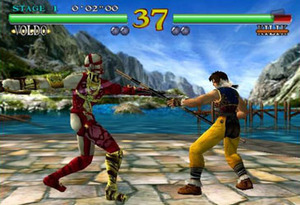
Soul Calibur
Publisher: Namco BandaiYear: 1999
Soul Calibur was, as you’ve probably heard (if not experienced for yourself), a pretty damned good game back in the days of the Dreamcast. What you’ve probably not heard since then is that the dimly remembered brilliance that most Dreamcast owners will recall when they think of the game actually isn’t affected by exaggeration or nostalgia.
Quite simply, Soul Calibur is still one of the best fighting games to ever grace a games console – possibly beaten only by Tekken II and the sequel Soul Calibur 2.
Soul Calibur’s secret to success isn’t one you can easily gauge by a bit of blurb and a handful of screenshots though. Like most truly good fighting games, the excellence lies not in the graphics or the idiotic backstories of the characters; the brilliance resides simply in the kinetics of the game, the constant sense of motion which is coupled with the deep strategies that can be divined from the complex counters and special attacks.
Soul Calibur stands out from other beat-em-ups, both of its period and modern day, in that it isn’t meant wholly as a multiplayer title. In fact, despite appearing on the Dreamcast, there’s no option for online play in Soul Calibur at all – making the game somewhat notable for ignoring the Dreamcast’s most notable feature. Instead, as well as the traditional Arcade Mode and Local Versus options there’s also a bunch of extra game types available to players, such as Survival and Mission Mode.
Mission Mode is definitely one of the highlights of the game for lonely gamers, offering up an expansive campaign of challenges for you to compete in. These aren’t challenges of the standard “Defeat X to progress” formula either, with many of the missions have their own unique twists. Either way, through completing them you can unlock a bunch of extra content for the game, from character art to new modes and weapons for your fighters to use.
Speaking of content, Soul Calibur is practically busting at the seams with more than 15 different characters available to unlock through the Arcade and Mission Modes, and plenty of extra weapons and costumes to customise them with. It’s not just filler content either – the weapons will actually change the abilities and moves of the players, while few of the characters overlap in terms of fighting styles. Those characters that do often vary in terms of size and strength.
The graphics are noticeably retro, lacking the polished edges and extravagant, bloom-saturated fireworks of the newer games in the series – but it doesn’t matter. The polygons may be few, but the basic bones of the game are there, and there’s still some facial animation and realistic animations – animations that’d put most modern games to shame, in fact. That goes double since the game is all about using different weapons, which is hardly the easiest thing in the world to animate.
So, there you have it – not only was Soul Calibur a fantastic beat-em-up back then, but it’s also still one of the best fighting games ever made, and something that should definitely bring fond memories to any Dreamcast owners. If you haven’t played it, then you definitely should. As we’ve pointed out time and again, Dreamcasts can be had fairly cheaply nowadays, or you can even pick the game up on the Xbox Live Arcade if you must. Either way, you’ve got to play it – Soul Calibur was, and remains, a classic.

MSI MPG Velox 100R Chassis Review
October 14 2021 | 15:04












Want to comment? Please log in.